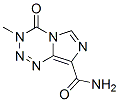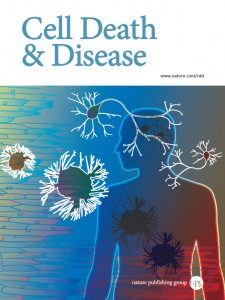All AbMole products are for research use only, cannot be used for human consumption.

Temozolomide (NSC 362856, CCRG 81045) is a DNA methylating agent used for the treatment of Grade IV astrocytoma. Temozolomide exhibits schedule-dependent antineoplastic activity by interfering with DNA replication. Temozolomide displays antitumor activity against a board spectrum of tumors, including leukemias, lymphomas and solid tumors (IC50 = 5.0 μM for cytotoxicity against mouse TLX5 lymphoma cells). Temozolomide induces G2/M arrest and apoptosis through adduction of a methyl group to O6 position of guanine in genomic DNA and functional inactivation of DNA repair protein O(6)-alkylguanine DNA alkyltransferase (AGT) in base excision repair (BER) pathway. Temozolomide treatment triggered ER stress with increased expression of GADD153 and GRP78 proteins, and deceased pro-caspase 12 protein. Temozolomide is currently in a phase II clinical trial in the treatment of melanoma.
The extinction coefficients of TMZ in acetate buffer 10 mM, pH = 4, at 330 nm is 9525 M–1·cm–1.
https://www.mdpi.com/2079-4991/14/1/55
TMZ concentration was estimated from absorbance measurements in a Suprasil quartz cuvette (Hellma Analytics) using Varian Cary 50 UV-Vis spectrophotometer (TMZ: λ = 330 nm, extinction coefficient from standard curve at 330 nm = 9800 M-1·cm-1 and for N3P: λ = 328 nm, extinction coefficient at 328 nm = 11100 M-1·cm-1).
https://pubs.acs.org/doi/10.1021/acsami.0c01514

Discov Oncol. 2025 Feb 05;16(1):119.
Circadian rhythm related genes signature in glioma for drug resistance prediction: a comprehensive analysis integrating transcriptomics and machine learning
Temozolomide purchased from AbMole

iScience. 2024 May 7.
Selective regulation of chemosensitivity in glioblastoma by phosphatidylinositol 3-kinase beta: iScience
Temozolomide purchased from AbMole

bioRxiv. 2024 Sep 16.
DNA Damage Response Deficiency Enhances Neuroblastoma Progression and Sensitivity to Combination PARP and ATR Inhibition
Temozolomide purchased from AbMole

J Exp Clin Cancer Res. 2023 May 10;42(1):118.
Piperlongumine conquers temozolomide chemoradiotherapy resistance to achieve immune cure in refractory glioblastoma via boosting oxidative stress-inflamation-CD8+-T cell immunity
Temozolomide purchased from AbMole

Nano Research. 2023 Jul 5.
Glioblastoma cell-derived exosomes functionalized with peptides as efficient nanocarriers for synergistic chemotherapy of glioblastoma with improved biosafety
Temozolomide purchased from AbMole

Patent. CN115869340A 2023 Mar 31.
Patent. CN115869340A
Temozolomide purchased from AbMole

Sci Adv. 2022 May 13;8(19):eabn1229.
Translesion DNA synthesis mediates acquired resistance to olaparib plus temozolomide in small cell lung cancer
Temozolomide purchased from AbMole

Patent. CN114686433A 2022 Jul 01.
Patent. CN114686433A
Temozolomide purchased from AbMole

Biochem Biophys Res Commun. 2021 Sep 10;569:1-9.
Rapid tumor recurrence in a novel murine GBM surgical model is associated with Akt/PD-L1/vimentin signaling
Temozolomide purchased from AbMole

Patent. CN112294811A 2021 Feb 02.
Patent. CN112294811A
Temozolomide purchased from AbMole

Cancer Lett. 2020 Jun 1;479:1-12.
Exosome-mediated Transfer of circRNA CircNFIX Enhances Temozolomide Resistance in Glioma
Temozolomide purchased from AbMole

Biomedicines. 2020 Jun 4;8(6):151.
Considering the Experimental use of Temozolomide in Glioblastoma Research
Temozolomide purchased from AbMole

bioRxiv. 2020 Oct.
Connexin 43 confers chemoresistance through activating PI3K
Temozolomide purchased from AbMole

Cell. 2019 Jun 13;177(7):1903-1914.e14.
Visualizing Engrafted Human Cancer and Therapy Responses in Immunodeficient Zebrafish.
Temozolomide purchased from AbMole

Cell Death Dis. 2018 Feb 12;9(2):213.
Autophagy mediates glucose starvationinduced glioblastoma cell quiescence and chemoresistance through coordinating cell metabolism, cell cycle, and survival
Temozolomide purchased from AbMole

J Clin Transl Sci. 2018 Nov 21;Vol2, Supplement S1, pp.11-12.
2036 Extracellular matrix as a novel approach to glioma therapy
Temozolomide purchased from AbMole

Cancer Lett. 2016 Aug 28;379(1):134-42.
HDAC6 promotes cell proliferation and confers resistance to temozolomide in glioblastoma
Temozolomide purchased from AbMole
| Cell Experiment | |
|---|---|
| Cell lines | A2058, A375, M238 and M249 cell lines |
| Preparation method | Colony formation assay Depending on the cell line (and plating efficiency), 200–1000 cells were seeded into each well of a 6-well plate and treated as described in detail previously. In the case of primary melanoma cells, 1000 cells were seeded and let grow for 24 days in the presence or absence of drug treatment; because only small colonies formed, the stained colonies were counted under the microscope.Survival of melanoma cells after drug treatment. Five different melanoma cell lines (as indicated), as well as a culture of primary melanoma tissue cells (labeled ‘primary’) were exposed to increasing concentrations of TMZ (diamonds) or NEO212 (circles) for 48 hours, and long-term survival was determined via colony formation assay (CFA). |
| Concentrations | 0, 25, 50, 75, 100µM |
| Incubation time | 48 h |
| Animal Experiment | |
|---|---|
| Animal models | A375 cells subcutaneous tumor growth model |
| Formulation | 45% glycerol, 45% ethanol, 10% DMSO |
| Dosages | 50 mg/kg |
| Administration | subcutaneous injection |
| Molecular Weight | 194.15 |
| Formula | C6H6N6O2 |
| CAS Number | 85622-93-1 |
| Solubility (25°C) | DMSO 18 mg/mL |
| Storage | -20°C, protect from light, sealed |
| Related DNA/RNA Synthesis Products |
|---|
| Deoxyribonucleic Acid (from Salmon sperm)
Deoxyribonucleic Acid (from Salmon sperm) can be used as a research reagent, widely used in molecular biology, pharmacology and other scientific research. |
| GSK4418959
GSK4418959 (IDE275) is a non-covalent, reversible, selective and orally active WRN helicase inhibitor. GSK4418959 inhibits ATPase and DNA unwinding functions in an ATP-competitive manner. |
| Dencatistat
Dencatistat (P115) is an inhibitor of Cytidine Triphosphate Synthase 1 (CTPS1) with an IC50 value of ≤ 0.1 μM. |
| Antipain dihydrochloride
Antipain dihydrochloride is a protease inhibitor. Antipain dihydrochloride inhibits N-methyl-N'-nitro-N-nitrosoguanidine (MNNG)-induced transformation and increases chromosomal aberrations. Antipain dihydrochloride also restricts uterine DNA synthesis and function in mice. |
| Tetrahydrouridine
Tetrahydrouridine (THU) is potent inhibitor of cytidine deaminase (CDA), which competitively blocks the enzyme's active site more effectively than intrinsic cytidine. |
All AbMole products are for research use only, cannot be used for human consumption or veterinary use. We do not provide products or services to individuals. Please comply with the intended use and do not use AbMole products for any other purpose.


Products are for research use only. Not for human use. We do not sell to patients.
© Copyright 2010-2024 AbMole BioScience. All Rights Reserved.
